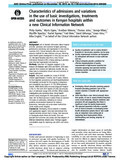Characteristics of admissions and variations in the use of basic investigations, treatments and outcomes in Kenyan hospitals within a new clinical information network.

View/
Date
2015Author
Ayieko, P
Ogero, M
Makone, B,
Julius, T
Mbevi, G
Nyachiro, W
Nyamai, R
Were, F
Type
ArticleLanguage
enMetadata
Show full item recordAbstract
BACKGROUND:
Lack of detailed information about hospital activities, processes and outcomes hampers planning, performance monitoring and improvement in low-income countries (LIC). Clinical networks offer one means to advance methods for data collection and use, informing wider health system development in time, but are rare in LIC. We report baseline data from a new Clinical Information Network (CIN) in Kenya seeking to promote data-informed improvement and learning.
METHODS:
Data from 13 hospitals engaged in the Kenyan CIN between April 2014 and March 2015 were captured from medical and laboratory records. We use these data to characterise clinical care and outcomes of hospital admission.
RESULTS:
Data were available for a total of 30 042 children aged between 2 months and 15 years. Malaria (in five hospitals), pneumonia and diarrhoea/dehydration (all hospitals) accounted for the majority of diagnoses and comorbidity was found in 17 710 (59%) patients. Overall, 1808 deaths (6%) occurred (range per hospital 2.5%-11.1%) with 1037 deaths (57.4%) occurring by day 2 of admission (range 41%-67.8%). While malaria investigations are commonly done, clinical health workers rarely investigate for other possible causes of fever, test for blood glucose in severe illness or ascertain HIV status of admissions. Adherence to clinical guideline-recommended treatment for malaria, pneumonia, meningitis and acute severe malnutrition varied widely across hospitals.
CONCLUSION:
Developing clinical networks is feasible with appropriate support. Early data demonstrate that hospital mortality remains high in Kenya, that resources to investigate severe illness are limited, that care provided and outcomes vary widely and that adoption of effective interventions remains slow. Findings suggest considerable scope for improving care within and across sites
Citation
Arch Dis Child. 2015 Dec 10. pii: archdischild-2015-309269Publisher
University of Nairobi
